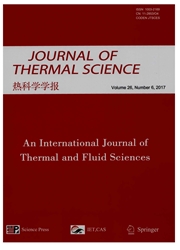

 中文摘要:
中文摘要:
An experimental and numerical study have been carried out to investigate the distribution of radial local heat transfer coefficients of impinging submerged circular jets. Good agreement is achieved between the experimental results and the predicted value. Results show that the outer peak usually occurs at the radial location of r/d= 1.8~2.0, in which transition from laminar to turbulence happens resulting from disappeared pressure gradient abruptly, and that the inner peak appears rigidly at r/d=0.5, where the boundary layer has a minimum thickness because of elevating pressure gradient.
 英文摘要:
英文摘要:
An experimental and numerical study have been carried out to investigate the distribution of radial local heat transfer coefficients of impinging submerged circular jets. Good agreement is achieved between the experimental results and the predicted value. Results show that the outer peak usually occurs at the radial location of r/d=1.8–2.0, in which transition from laminar to turbulence happens resulting from disappeared pressure gradient abruptly, and that the inner peak appears rigidly at r/d=0.5, where the boundary layer has a minimum thickness because of elevating pressure gradient.
 同期刊论文项目
同期刊论文项目
 同项目期刊论文
同项目期刊论文
 期刊信息
期刊信息
